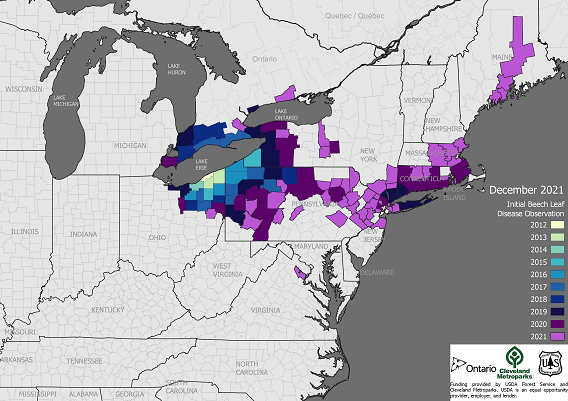By Ethan Wachendorf, Forest Health Lab Technician, Fitchburg, ethan.wachendorf@wisconsin.gov or 608-273-6276
Forest owners and land managers should be on the lookout for beech leaf disease (BLD), a destructive disease of beech trees. The disease is primarily found on American beech (Fagus grandifolia) but can also be found on ornamental species like European, Oriental and Chinese beech (F. sylvatica, F. orientalis and F. engleriana).
Although it has not yet been found in Wisconsin, recent discoveries of the disease in Virginia, New Hampshire and Michigan highlight the continued importance of monitoring BLD’s expansion. There is potential for BLD to move into Wisconsin, as the eastern portion of the state overlaps with the American beech tree’s native range.
Symptomatic American beech were first found in Lake County, Ohio in 2012. The current range of the disease covers parts of Connecticut, Maine, Michigan, Massachusetts, New Hampshire, New Jersey, New York, Ohio, Pennsylvania, Rhode Island, Virginia, West Virginia and Ontario, Canada.

Initial beech leaf disease observation by year. Photo: Ontario, USDA Forest Service & Cleveland Metroparks
Symptomatic trees can be identified by dark striping or banding between leaf veins on multiple leaves of a tree. This can be most easily spotted from the undersides of leaves while looking up into the canopy.
More severe symptoms include leaf distortion, such as curling, puckering, thickening and developing leathery texture or necrotic (dead) leaf tissue. Other symptoms include aborted buds, branch and tip dieback and premature leaf drop leading to a thinning canopy.
The most susceptible trees are saplings and younger, smaller beeches, which can die within 3-5 years of symptom development. Disease progression and mortality still occur in older beeches but typically over a longer period.
Recent research has identified Litylenchus crenatae mccannii, a newly described roundworm, as a necessary condition for symptom development. While the infection mechanism is still unknown, the roundworm is associated with the leaves and buds of beech trees. They overwinter in buds and may be found in leaf tissue beginning in June or July.
Symptom detection may not be possible for some time after infestation; however, early detection techniques through molecular methods and infrared technologies are in progress. Detection difficulty means that BLD may become established before symptomatic trees are discovered, such as in Michigan.
Beech trees are important to our forests for many reasons, including providing food for wildlife. If you see symptoms of beech leaf disease in Wisconsin, please contact your regional forest health specialist.


